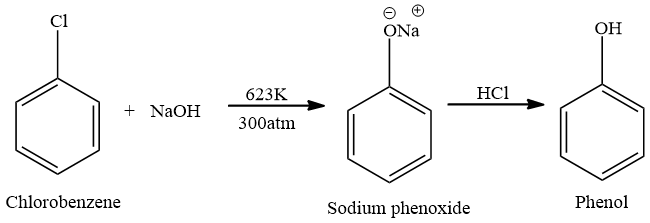Answer
396k+ views
Hint: Chlorobenzene has partial double bond character. Removal of chlorine atom from benzene rings requires high temperature and high pressure.
Complete answer:
Phenol is an organic compound containing a benzene ring bonded to the hydroxyl group.Phenol are weak acids and generally form phenoxide ions by losing one positive hydrogen ion from the hydroxyl group.
Chlorobenzene is formed by monochlorination of the benzene ring. To form chloro benzene, the Benzene ring is reacted with chlorine gas and $FeC{{l}_{3}}$. The lone pair of electrons present on chlorine atoms are in conjugation with the pie electrons of the benzene ring, therefore, Chlorobenzene is having a double bond character therefore, removal of chlorine atom from benzene is not easy. Removal of chlorine from benzene atoms requires high pressure and temperature,because chlorobenzene is less reactive and does not undergo nucleophilic substitution reaction easily. Therefore, for removal of chlorine atom, Chlorobenzene is reacted with Sodium Hydroxide at high pressure of 300 atm and high temperature of 623K. This results in the formation of sodium phenoxide. Sodium phenoxide on acidification with HCl results in the formation of Phenol.

Note: When the electron withdrawing group is attached to the benzene ring, the removal of chlorine group becomes easy. When an electron withdrawing group like Nitro group, cyano group is attached to the ortho or para position of chlorobenzene. Trinitro chlorobenzene is highly reactive and gets hydrolysed at room temperature.
Complete answer:
Phenol is an organic compound containing a benzene ring bonded to the hydroxyl group.Phenol are weak acids and generally form phenoxide ions by losing one positive hydrogen ion from the hydroxyl group.
Chlorobenzene is formed by monochlorination of the benzene ring. To form chloro benzene, the Benzene ring is reacted with chlorine gas and $FeC{{l}_{3}}$. The lone pair of electrons present on chlorine atoms are in conjugation with the pie electrons of the benzene ring, therefore, Chlorobenzene is having a double bond character therefore, removal of chlorine atom from benzene is not easy. Removal of chlorine from benzene atoms requires high pressure and temperature,because chlorobenzene is less reactive and does not undergo nucleophilic substitution reaction easily. Therefore, for removal of chlorine atom, Chlorobenzene is reacted with Sodium Hydroxide at high pressure of 300 atm and high temperature of 623K. This results in the formation of sodium phenoxide. Sodium phenoxide on acidification with HCl results in the formation of Phenol.

Note: When the electron withdrawing group is attached to the benzene ring, the removal of chlorine group becomes easy. When an electron withdrawing group like Nitro group, cyano group is attached to the ortho or para position of chlorobenzene. Trinitro chlorobenzene is highly reactive and gets hydrolysed at room temperature.
Recently Updated Pages
Basicity of sulphurous acid and sulphuric acid are

Three beakers labelled as A B and C each containing 25 mL of water were taken A small amount of NaOH anhydrous CuSO4 and NaCl were added to the beakers A B and C respectively It was observed that there was an increase in the temperature of the solutions contained in beakers A and B whereas in case of beaker C the temperature of the solution falls Which one of the following statements isarecorrect i In beakers A and B exothermic process has occurred ii In beakers A and B endothermic process has occurred iii In beaker C exothermic process has occurred iv In beaker C endothermic process has occurred

What is the stopping potential when the metal with class 12 physics JEE_Main

The momentum of a photon is 2 times 10 16gm cmsec Its class 12 physics JEE_Main

How do you arrange NH4 + BF3 H2O C2H2 in increasing class 11 chemistry CBSE

Is H mCT and q mCT the same thing If so which is more class 11 chemistry CBSE

Trending doubts
Difference between Prokaryotic cell and Eukaryotic class 11 biology CBSE

Fill the blanks with the suitable prepositions 1 The class 9 english CBSE

Write an application to the principal requesting five class 10 english CBSE

Difference Between Plant Cell and Animal Cell

a Tabulate the differences in the characteristics of class 12 chemistry CBSE

Change the following sentences into negative and interrogative class 10 english CBSE

What organs are located on the left side of your body class 11 biology CBSE

Discuss what these phrases mean to you A a yellow wood class 9 english CBSE

List some examples of Rabi and Kharif crops class 8 biology CBSE



